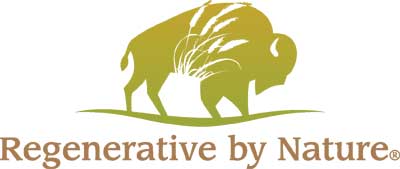Regenerative Farming
Ozark Valley Bison Ranch practices holistic management and regenerative farming practices.
What is Regenerative Farming
In simple terms, it is farming in harmony with nature to fight climate change, improve water quality, and protect biodiversity. It is the belief that the parts of something are all interconnected and must be practiced with reference to the whole.

Regenerative farming is rooted in indigenous wisdom in which decision-making is set on principles and practices to grow food in harmony with nature and heal the land from degradation. It involves the understanding of the land's natural resource availability, prioritizing soil health, reducing and eventually eliminating the use of chemicals, and integrating animals onto available. The basic principles are:
- enhancing and improving soil health
- optimization of resource management
- alleviation of climate change
- improvement of water quality and availability
As a philosophy it is a conservation and rehabilitation approach to food and farming systems. It considers how all aspects of agriculture are connected through a network of facilities that grow, enhance, exchange, distribute, and consume goods and services instead of a simple linear supply chain. It's all about farming in a style that nourishes the earth, with specific practices that vary from grower to grower and from region to region in response to the environment. There are no strict rule books, but the holistic principles of regenerative agriculture are meant to restore soil and ecosystem health, address inequity, and leave our land, waters, and climate in better shape for future generations.
Some of what we do
We raise our bison herd in a low stress lifestyle, keeping in mind the quality of life of the animal, the impact our process has on the environment and the impact our actions have on the quality of our meat.
Rotational grazing. We practice rotational grazing that helps to prevent selective grazing, thereby allowing diversity of available plant life to flourish. During drought or other adverse conditions that affect forage growth, animals are allowed to self-rotate through pastures. As bison are naturally migratory animals, they are quite efficient in self-rotational grazing which is why they are considered regenerative in nature.
Regenerative pastures. Once bison stop self-migration and congregate into the winter pasture where hay is available, but no later than February 15th, animals are contained within our winter pasture allowing the primary pastures to regenerate and reach a height of at least 6 inches before rotational grazing is resumed in the spring (generally early April).
Manure handling. While animals are contained within the winter sacrificial pasture, the pastures are chain harrowed to spread out manure on the pasture thereby reducing or eliminating the amount of fertilizer required. After animals are removed from the winter pasture, the area where hay was fed is cleaned of manure and piled for static pile composting. The compost is spread on the fields the following year, thereby further reducing the need of fertilizers.
Limited use of herbicides. We limit the use of herbicides and use natural compounds when ever possible. Under our Animal Welfare certification, organophosphates (such as glyphosate/roundup) are strictly prohibited.
No-till planting. If re-seeding of pastures and/or winter pasture is required we only employ no-till planting and/or simple broadcast. No-till farming has been proven to reduce soil erosion by 98%
